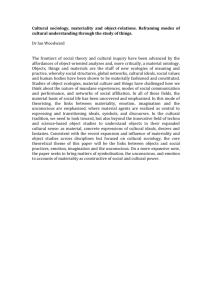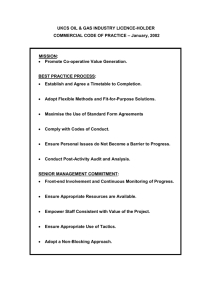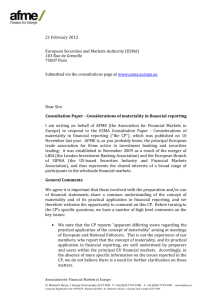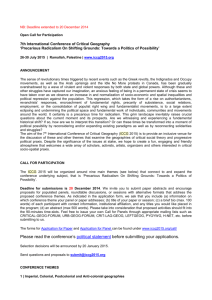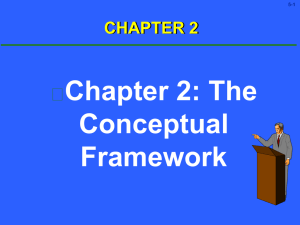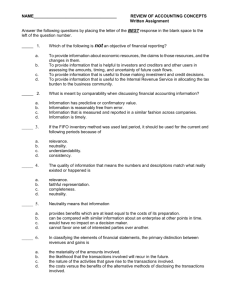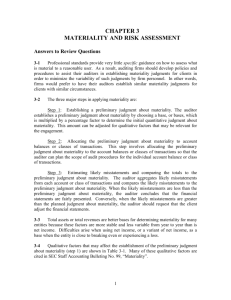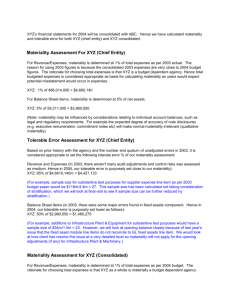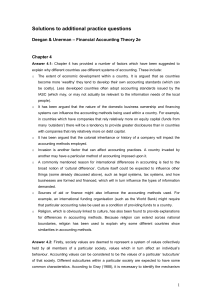Deutsches Rechnungslegungs Standards Committee eV Accounting
advertisement
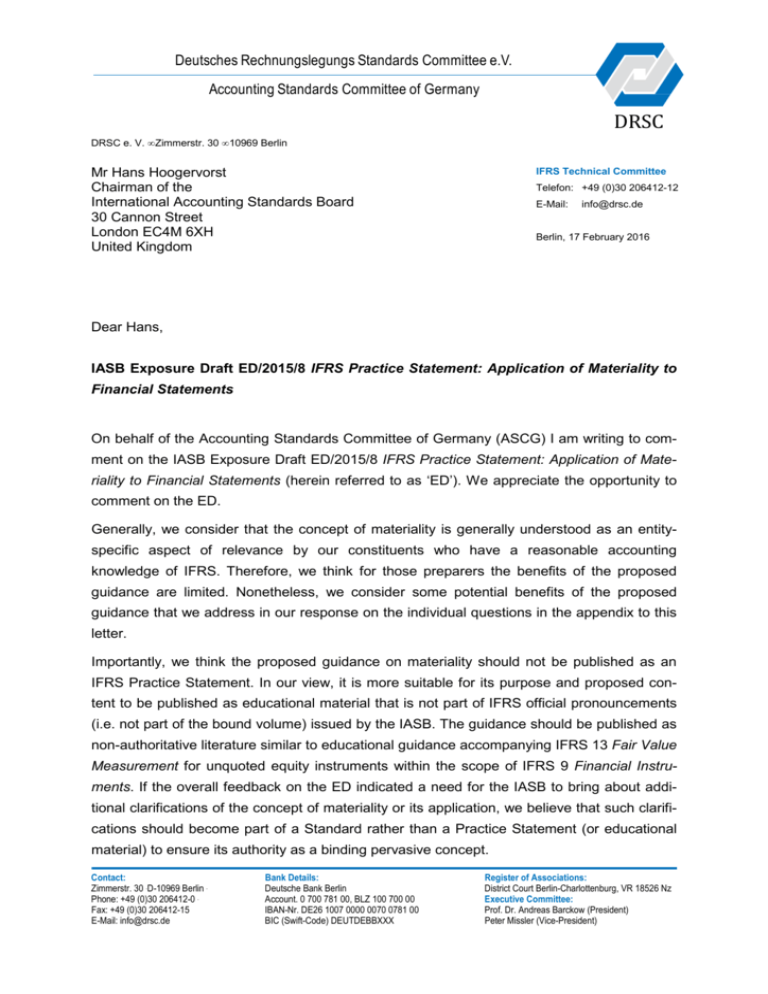
Deutsches Rechnungslegungs Standards Committee e.V. Accounting Standards Committee of Germany DRSC DRSC e. V. • Zimmerstr. 30 • 10969 Berlin Mr Hans Hoogervorst Chairman of the International Accounting Standards Board 30 Cannon Street London EC4M 6XH United Kingdom IFRS Technical Committee Telefon: +49 (0)30 206412-12 E-Mail: info@drsc.de Berlin, 17 February 2016 Dear Hans, IASB Exposure Draft ED/2015/8 IFRS Practice Statement: Application of Materiality to Financial Statements On behalf of the Accounting Standards Committee of Germany (ASCG) I am writing to comment on the IASB Exposure Draft ED/2015/8 IFRS Practice Statement: Application of Materiality to Financial Statements (herein referred to as ‘ED’). We appreciate the opportunity to comment on the ED. Generally, we consider that the concept of materiality is generally understood as an entityspecific aspect of relevance by our constituents who have a reasonable accounting knowledge of IFRS. Therefore, we think for those preparers the benefits of the proposed guidance are limited. Nonetheless, we consider some potential benefits of the proposed guidance that we address in our response on the individual questions in the appendix to this letter. Importantly, we think the proposed guidance on materiality should not be published as an IFRS Practice Statement. In our view, it is more suitable for its purpose and proposed content to be published as educational material that is not part of IFRS official pronouncements (i.e. not part of the bound volume) issued by the IASB. The guidance should be published as non-authoritative literature similar to educational guidance accompanying IFRS 13 Fair Value Measurement for unquoted equity instruments within the scope of IFRS 9 Financial Instruments. If the overall feedback on the ED indicated a need for the IASB to bring about additional clarifications of the concept of materiality or its application, we believe that such clarifications should become part of a Standard rather than a Practice Statement (or educational material) to ensure its authority as a binding pervasive concept. Contact: Zimmerstr. 30 .D-10969 Berlin . Phone: +49 (0)30 206412-0 . Fax: +49 (0)30 206412-15 E-Mail: info@drsc.de Bank Details: Deutsche Bank Berlin Account. 0 700 781 00, BLZ 100 700 00 IBAN-Nr. DE26 1007 0000 0070 0781 00 BIC (Swift-Code) DEUTDEBBXXX Register of Associations: District Court Berlin-Charlottenburg, VR 18526 Nz Executive Committee: Prof. Dr. Andreas Barckow (President) Peter Missler (Vice-President) Deutsches Rechnungslegungs Standards Committee e.V. Accounting Standards Committee of Germany DRSC In addition, we are of the view that the guidance should not include any reference of its status with respect to achieving compliance with IFRSs. In our view, the guidance reflects the common understanding of materiality as a mandatory pervasive concept underlying current IFRS and should be considered as educational help regarding the application of the concept. Furthermore, we think the IASB should consider the initial feedback of the upcoming Discussion Paper for its Principles of Disclosure project before finalising the guidance on materiality to the financial statements. If you would like to discuss our comments further, please do not hesitate to contact Holger Obst or me. Yours sincerely, Andreas Barckow President -2- Deutsches Rechnungslegungs Standards Committee e.V. Accounting Standards Committee of Germany DRSC Appendix – Answers to the questions of the exposure draft Question 1 — Form of the guidance A Practice Statement is not a Standard. The IASB’s reasoning for issuing guidance on applying the concept of materiality in the financial statements in the form of a nonmandatory Practice Statement is set out in paragraphs BC10–BC15. a) Do you think that the guidance should be issued as non-mandatory guidance? Why or why not? b) Do you think that a Practice Statement is the appropriate form for non-mandatory guidance on applying the concept of materiality? Why or why not? If not, what alternative(s) do you propose and why? Response to question 1(a): The guidance should be published as non-authoritative literature in the format of educational guidance similar to existing educational material to address the application of principles in IFRS 13 Fair Value Measurement.1 In our view, the format of educational material - that is not part of IFRS official pronouncements (i.e. not part of the bound volume) issued by the IASB - is more suitable for its purpose and already used by the IASB. In addition, we highlight the fact that, currently, the IASB does not make a distinction between mandatory and non-mandatory guidance. Current IFRSs have the distinction whether guidance is an integral part of a Standard or not. Furthermore, educational material is declared as non-authoritative that has not been approved by the IASB. We are concerned that the new term of “non-mandatory” guidance creates confusion about its status compared to existing publication issued by the IASB about concepts and principles that are part of current IFRSs. Furthermore within this context, the guidance should not include, as currently drafted in paragraph 6 of the ED, any reference of its status with respect to achieving compliance with IFRS. The wording appears to be counterproductive because it could encourage preparers to neglect examples when application of materiality would be inappropriate. For example paragraph 58 of the ED states that it would not be appropriate to omit information about the entity that is specifically required by IFRSs from the financial statements solely because it had previously been included in a press release or other publicly available document. Similarly, paragraph 27 of the ED states that an example of an inadequate […] disclosure would be if an 1 http://www.ifrs.org/Use-around-the-world/Education/FVM/Documents/Education-guidance-FVM.pdf -3- Deutsches Rechnungslegungs Standards Committee e.V. Accounting Standards Committee of Germany DRSC entity simply quotes the requirements in IFRSs without tailoring the description of its accounting policy to explain how it has been applied by the entity. We think preparers should not be encouraged to ignore such examples by highlighting the fact that the guidance is not necessary for declaring compliance with IFRSs. Response to question 1(b): As stated above, we think the guidance should be issued as educational material. Currently, the IFRS Practice Statement Management Commentary is used for the reporting of information that is not required by preparers to comply with IFRSs. However, guidance on materiality is different because the concept is required and pervasive to the preparation of financial statements. In other words, application of the concept of materiality is mandatory for preparers to comply with IFRSs. Nonetheless, if certain parts of the guidance are considered to provide clarifications regarding the mandatory concept of materiality, we think those clarifications should be included as part of a specific Standard. Otherwise, those clarifications of materiality cannot have a binding character for preparers because IFRS Practice Statements are not subject to endorsement in the EU. For example, we think the clarifications in the ED about the different roles of primary financial statements and notes in the ED would need to be part of IAS 1. It is our understanding that those clarifications and possible changes to the materiality definition are part of the proposals in the upcoming Discussion Paper of the IASB’s Principles of Disclosure project for a general disclosure Standard. Question 2 — Illustrative examples Do you find the examples helpful in the [draft] Practice Statement? Do you think any additional practical examples should be included? If so, what scenarios should the examples address? Please be as specific as possible and explain why those example(s) would be helpful to entities. We think that examples are especially helpful if they provide additional information that is not already obvious to the reader from existing guidance in IAS 1 and IAS 8. For example, we think it is helpful if guidance provides clear statements whether a particular approach for applying materiality is inappropriate or inadequate, as highlighted in paragraphs 27 and 58 of the ED. Nonetheless, we think many examples either merely repeat current IFRS guidance or remain vague and are therefore without substantial help for preparers with a reasonable knowledge of IFRS. -4- Deutsches Rechnungslegungs Standards Committee e.V. Accounting Standards Committee of Germany DRSC In our view, it could be helpful to provide examples that specifically address judgement about qualitative notes disclosure. Particularly, we think it would be helpful to provide guidance on the application of materiality regarding qualitative disclosure requirements for specific transactions or events that are not presented as separate line items in the primary financial statements. Most disclosure requirements in IFRSs for specific transactions or events seemed to have been developed implying that the specific transaction or event would be presented as separate line items in the primary financial statements and, therefore, justify the wide range of additional required disclosures. Therefore, question often arise to what extent, especially qualitative disclosures, could be omitted if the specific transaction or events is not depicted as separate line item in the primary financial statements. In this context, we understand that the upcoming Discussion Paper for the Principles of Disclosure project might provide additional helpful guidance based on the proposals of introducing a two-tiers disclosure approach for the notes. In addition, we think the guidance should provide illustrative examples regarding the techniques and factors to be considered when evaluating whether and when an accounting error is material. In our view, the ED does not provide overly helpful guidance on this issue, which is frequently discussed in practice. In this context, we refer to existing guidance for US GAAP issued by the US Securities and Exchange Commission describing with illustrative examples the “rollover” and “iron curtain” approaches for materiality assessment of accounting errors.2 We believe a similar discussion in educative material to be developed could be of benefit for constituents, especially preparers. 2 US SEC, Staff Accounting Bulletin No. 108, 2006 (https://www.sec.gov/interps/account/sab108.pdf) -5- Deutsches Rechnungslegungs Standards Committee e.V. Accounting Standards Committee of Germany DRSC Question 3 — Content of the [draft] Practice Statement The [draft] Practice Statement proposes guidance in three main areas: (a) characteristics of materiality; (b) how to apply the concept of materiality in practice when presenting and disclosing information in the financial statements; and (c) how to assess whether omissions and misstatements of information are material to the financial statements. It also contains a short section on applying materiality when applying recognition and measurement requirements. Please comment on the following and provide any suggestions you have for improving the [draft] Practice Statement: (a) Do you think that any additional content should be included in the Practice Statement? If so, what additional content should be included and why? (b) Do you think the guidance will be understandable by, and helpful to, preparers of financial statements who have a reasonable level of business/accounting knowledge and IFRS? If not, which paragraphs/sections are unclear or unhelpful and why? (c) Are there any paragraphs/sections with which you do not agree? If so, which paragraphs/sections are they and why? (d) Do you think any paragraphs/sections are unnecessary? If so, which paragraphs/sections are they and why? (e) Do you think any aspects of the guidance will conflict with any legal requirements related to materiality within your jurisdiction, or a jurisdiction in which you file financial statements? Response to question 3 (a): As already indicated in our response to question 2 above, we think the guidance should include more educational help for preparers and other constituents regarding possible approaches of materiality assessment on accounting errors. We think such guidance is missing in the section on ‘Omissions and misstatements’ (paragraphs 67-79) of the ED. The guidance would be helpful because it is often subject to debate whether the approaches described by the US SEC for US GAAP should also be considered for the definition and identification of material errors in IAS 8 Accounting Policies, Changes in Accounting Estimates and Errors. We assume that this issue and a corresponding discussion do not only apply to our jurisdiction and would, thus, be beneficial for many. -6- Deutsches Rechnungslegungs Standards Committee e.V. Accounting Standards Committee of Germany DRSC Response to question 3(b): In our view, many parts of the proposed guidance repeat what is already included in current IFRSs. Many conclusion depicted in the ED are self-evident from current IFRSs for preparers that have a reasonable accounting knowledge of IFRSs. We think that the concept of materiality is already clearly and consistently understood as an entity-specific aspect of relevance by our constituents who have a reasonable accounting knowledge of IFRSs3. Thus, as addressed in our response to question 2, we think the guidance provides limited help for preparers of financial statements who have a reasonable level of business/accounting knowledge and IFRSs. Nonetheless, we think the guidance can be helpful as educational material. In our view, the main blocking issues for applying materiality do not relate to the understanding of materiality but the more costly process of actively applying and justifying materiality judgement. In this context, we think the proposed guidance might have merits by providing a form of compendium and reminder about the concept of materiality and its implications for preparing financial statements. It might also be helpful in reminding preparers to exercise a constant review process whether disclosures are still considered to be material compared to previous reporting periods. Furthermore, the guidance is helpful in making preparers aware that materiality judgement must be considered in different contexts, i.e. materiality in the context of different roles/objectives of providing information that is often missing in current IFRSs. For example, the Practice Statement refers to the distinction of primary financial statements versus the notes and their different roles. So far, this distinction does not exist in current IFRSs but will be proposed in the upcoming Discussion Paper in the Principles of Disclosure project as amendment to IAS 1. However, another important blocking issue for the application of materiality on notes disclosure is the absence of clear and sufficiently specific objectives for disclosure requirements. This issue can only be addressed with a review of existing IFRS disclosure guidance in particular Standards. Response to question 3(c): 3 We also refer to our response to the consultation document by ESMA on materiality in March 2012: http://www.drsc.de/docs/press_releases/2012/120313_CL_IFRSFA_ESMA_Materiality.pdf?date=2015-11-2 -7- Deutsches Rechnungslegungs Standards Committee e.V. Accounting Standards Committee of Germany DRSC As we have already addressed in our response to question 1, the reference to the status of the guidance with respect to the achievement of compliance with IFRS in paragraph IN6 of the ED should be removed. The guidance should reflect the common understanding of materiality as a mandatory pervasive concept underlying current IFRSs and should be considered as educational help regarding the application of the concept. Therefore, the introduction of the guidance should not encourage preparers to assert that the document is completely negligible regarding the evaluation of fair presentation and compliance with IFRSs. Response to question 3(d): As addressed in our responses above, we think that, in many parts, the drafted guidance remains very vague and merely repeats what is already included in IFRSs. Also, many examples in the ED could be slightly changed or reinterpreted with a different conclusion for the application of materiality. Therefore, it is questionable whether those parts of guidance in their current form are truly necessary or helpful. Nonetheless, if the content were issued as educational guidance that repeats IFRS guidance from a more comprehensive and education perspective in one place, we would believe that it can be useful for the reasons addressed in our response to question 3(c). Response to question 3(e): We are not aware of potential conflicts with other legal requirements in our jurisdiction. However, we refer to the fact that the endorsement process for IFRSs in Europe does not encompass IFRS Practice Statements nor any other literature that is not an integral part of a standard. Therefore, the IFRS Practice Statement (or educational material) could not, by itself, constitute a legally binding character for preparers. -8- Deutsches Rechnungslegungs Standards Committee e.V. Accounting Standards Committee of Germany DRSC Question 4 — Timing The IASB plans to issue the Practice Statement before the finalisation of its Principles of Disclosure project. The IASB has tentatively decided to include a discussion on the definition of materiality, and whether there is a need to change or clarify that definition within IFRS, in the Discussion Paper for its Principles of Disclosure project (expected to be issued early in 2016). Nevertheless, the IASB thinks that to address the need for guidance on the application of materiality, it is useful to develop the Practice Statement now. The IASB does not envisage that the discussion about the definition of materiality or any other topics in its Principles of Disclosure project will significantly affect the content of the Practice Statement. Nevertheless, the IASB will consider whether any consequential amendments to the Practice Statement are necessary following the completion of the Principles of Disclosure project. Do you agree with this approach? We think it is difficult to anticipate whether the Principles of Disclosure project will significantly affect the content of the proposed guidance regarding the application of materiality to the financial statements. We think that any need to change or to clarify the definition of materiality could represent a significant change that would require an update of the proposed guidance. Therefore, in our view, the IASB could wait for the initial feedback by constituents on the Discussion Paper for its Principles of Disclosure project before finalising any guidance or educational material regarding the application of materiality. Furthermore, in our view, new implications or changes to the application guidance on materiality might not only arise from the discussion of amending the definition of materiality. For example, it is our understanding that the IASB will include some proposals for introducing a two-tier approach for notes disclosure4 in the Discussion Paper for its Principles of Disclosure project. Such a two-tier approach, if introduced for IFRSs, would ultimately imply a different context of materiality application and therefore a potential object for further guidance. Similarly, any disagreement with the Discussion Paper for the Principles of Disclosure project and its proposed description and implications of the different roles of the primary financial statements and the notes could significantly impact the proposed guidance in this ED. The guidance in the ED might also be expanded if the feedback on the upcoming Discussion paper would be supportive for some of the conclusions in the Discussion Paper. For example, 4 Agenda Paper 11B, IASB Meeting, September 2015. -9- Deutsches Rechnungslegungs Standards Committee e.V. Accounting Standards Committee of Germany DRSC the ED does not discuss whether or not a particular statement is seen as a primary financial statement. In the Principles of Disclosure project, it is presumed that each primary financial statement is required to be issued as part of a complete set of financial statements, i.e. materiality cannot be used [emphasis added] to determine whether individual primary financial statements should be issued5. Question 5 — Any other comments Do you have any other comments on the [draft] Practice Statement? As mentioned in Question 4, a discussion about the definition of materiality will be included in the Discussion Paper in the Principles of Disclosure project, so the IASB is not asking for comments on the definition at this time. We think that the IASB should address the issue of terminology indicating different levels of materiality. Currently, different words are used in IFRS guidance to describe similar concepts, such as ‘significant’, ‘key’, ‘critical’, etc. Since these terms are neither defined nor elaborated on in IFRS, determining their meaning and relative order can be difficult when dealing with materiality.6 Therefore, we believe that it would be helpful to clarify and define the terms to avoid inconsistent usage across IFRSs. 5 Agenda Paper 11B, IASB Meeting, March 2015. Similar issues regarding the meaning of different terms of likelihood in IFRS were presented to the IASB at the ASAF meeting in December 2015. - 10 6
